Hi folks,
I have been using my old Ghillie kettle for a number of years now and I love it to bits.
But now I have been given the anodised aluminium Kettle to try out.
Ok where to start...

Guess which is the Anodised Kettle
When I first took the Anodised Kettle it out of the box and was comparing it next to my old aluminium Ghillie my wife’s first words were it looks nicer than my old kettle. But that’s not hard as my old one has been well used over last few years. The old kettle is slightly worn through lots of use, but it is still going strong. And is one of my most used bits of camping kit that I have. Not only is it used when I’m out in the woods, but also when I’m camping with the family.
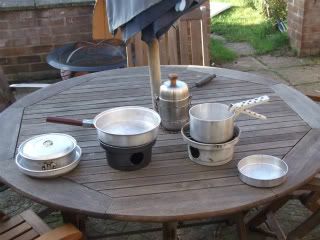
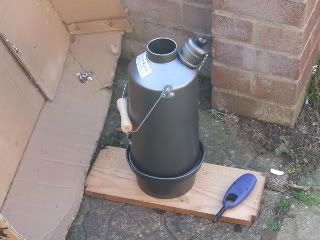
Some of my cookware
The only differences with the new kettle (apart from the anodising). Is that it has a curved in handle which looks like nicer than the straight one on my old kettle. And the knob on the whistle is bigger than on my old kettle making it easier to hold the whistle without holding any hot part of it of the whistle.
I'm not going to go into the process of hard anodised aluminium. As I'm sure many of you folk know more about it than I do.
But here is a link to have a for anyone who wants to know anything more about the (other websites are available) http://www.wisegeek.com/what-is-hard-anodizing.htm
But basically the Anodised kettle was made because people were asking for something stronger than the aluminium kettle. And as a process to make a stainless steel kettle would cost anything up to £100 each for it to be made here in Britain.That would cost more than most of us would be willing to pay. So because of costing Ghillie started to make anodised kettles instead.
The anodising process makes the kettle as strong as stainless steel, it conductsheat better than the aluminium kettle, also it has improved wear and corrosion resistance and as my wife says it looks nicer.
After the initial taking of pictures I filled the kettle up and tried to light a fire inthe base. Never easy on a very windy day my garden even worse when the wind is getting spun round and round in the area I was setting up the kettle. I normally use pine cones and small stick when using the kettle. But spiritwalker had asked the question in the kit chatter forum if briquettes or lumpwood charcoal would be too hot for the base. I thought I would use four lumps of briquette from a bag that I had left over from summer all covered with barbecue lighter fluid. And a barbecue match to get the fire started.

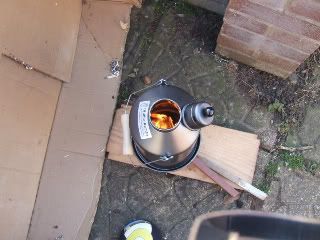

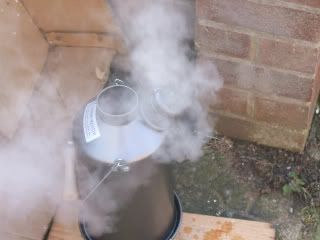
As normal when anyone lights a barbecue you have to leave it up to half an hour to let the briquettes heat up, and this test was nothing different to that. It was taking too much time for my liking to heat up so I added some wood in the base so the water would boil quicker, which it did rather faster than I was expecting
But after this the briquettes were still really hot so I thought I would make myself a snack. So I got my Ghillie cook set and used the lid part to fry an egg so I could make myself an egg banjo. The briquettes really worked well but as it was still windy the egg was taking a bit too long to cook so I added a lid from my granddads old scout camping cook set to keep the heat in the pan.
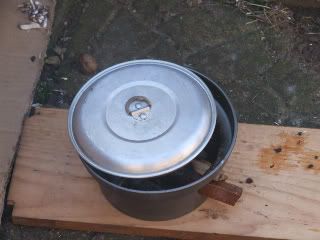
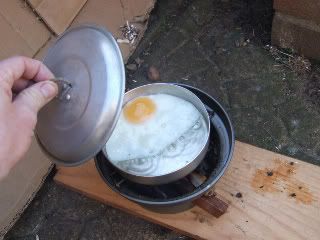
Now the worst part of the test the cleaning... Ok I had only used it for boiling once and frying a single egg and I’m sure it would be a bit different after a few days of use in the field. But it did clean off very easily even the base cleaned ok but there was some mis-colouring from where the briquettes had been but that’s normal and it’s going to happen anyway (my old ghillie’s base is black after all its use). But the base and the rest of the kettle were both fine and no damage was done by using briquettes. And that always a good thing to know J
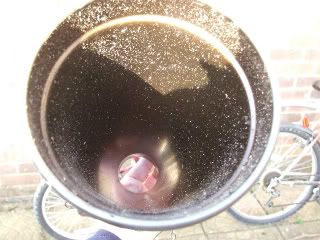

As I said at the beginning I love my old Ghillie kettle and I still do!
But the Anodised Kettle does look nicer and that it is stronger and with all the other benefits of anodising processI can see me being slightly unfaithful and using the Anodised Kettle quite a bit more.
I have been using my old Ghillie kettle for a number of years now and I love it to bits.
But now I have been given the anodised aluminium Kettle to try out.
Ok where to start...

Guess which is the Anodised Kettle
When I first took the Anodised Kettle it out of the box and was comparing it next to my old aluminium Ghillie my wife’s first words were it looks nicer than my old kettle. But that’s not hard as my old one has been well used over last few years. The old kettle is slightly worn through lots of use, but it is still going strong. And is one of my most used bits of camping kit that I have. Not only is it used when I’m out in the woods, but also when I’m camping with the family.


Some of my cookware
The only differences with the new kettle (apart from the anodising). Is that it has a curved in handle which looks like nicer than the straight one on my old kettle. And the knob on the whistle is bigger than on my old kettle making it easier to hold the whistle without holding any hot part of it of the whistle.
I'm not going to go into the process of hard anodised aluminium. As I'm sure many of you folk know more about it than I do.
But here is a link to have a for anyone who wants to know anything more about the (other websites are available) http://www.wisegeek.com/what-is-hard-anodizing.htm
But basically the Anodised kettle was made because people were asking for something stronger than the aluminium kettle. And as a process to make a stainless steel kettle would cost anything up to £100 each for it to be made here in Britain.That would cost more than most of us would be willing to pay. So because of costing Ghillie started to make anodised kettles instead.
The anodising process makes the kettle as strong as stainless steel, it conductsheat better than the aluminium kettle, also it has improved wear and corrosion resistance and as my wife says it looks nicer.
After the initial taking of pictures I filled the kettle up and tried to light a fire inthe base. Never easy on a very windy day my garden even worse when the wind is getting spun round and round in the area I was setting up the kettle. I normally use pine cones and small stick when using the kettle. But spiritwalker had asked the question in the kit chatter forum if briquettes or lumpwood charcoal would be too hot for the base. I thought I would use four lumps of briquette from a bag that I had left over from summer all covered with barbecue lighter fluid. And a barbecue match to get the fire started.




As normal when anyone lights a barbecue you have to leave it up to half an hour to let the briquettes heat up, and this test was nothing different to that. It was taking too much time for my liking to heat up so I added some wood in the base so the water would boil quicker, which it did rather faster than I was expecting
But after this the briquettes were still really hot so I thought I would make myself a snack. So I got my Ghillie cook set and used the lid part to fry an egg so I could make myself an egg banjo. The briquettes really worked well but as it was still windy the egg was taking a bit too long to cook so I added a lid from my granddads old scout camping cook set to keep the heat in the pan.


Now the worst part of the test the cleaning... Ok I had only used it for boiling once and frying a single egg and I’m sure it would be a bit different after a few days of use in the field. But it did clean off very easily even the base cleaned ok but there was some mis-colouring from where the briquettes had been but that’s normal and it’s going to happen anyway (my old ghillie’s base is black after all its use). But the base and the rest of the kettle were both fine and no damage was done by using briquettes. And that always a good thing to know J


As I said at the beginning I love my old Ghillie kettle and I still do!
But the Anodised Kettle does look nicer and that it is stronger and with all the other benefits of anodising processI can see me being slightly unfaithful and using the Anodised Kettle quite a bit more.


